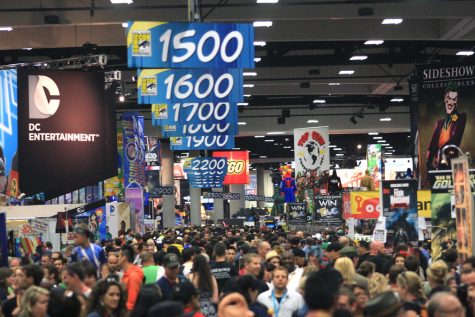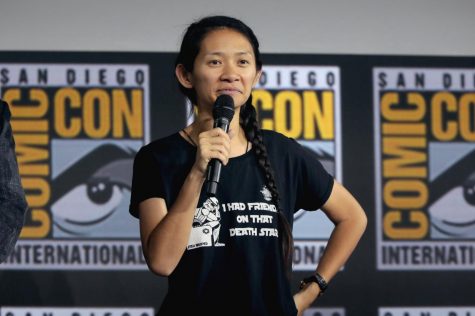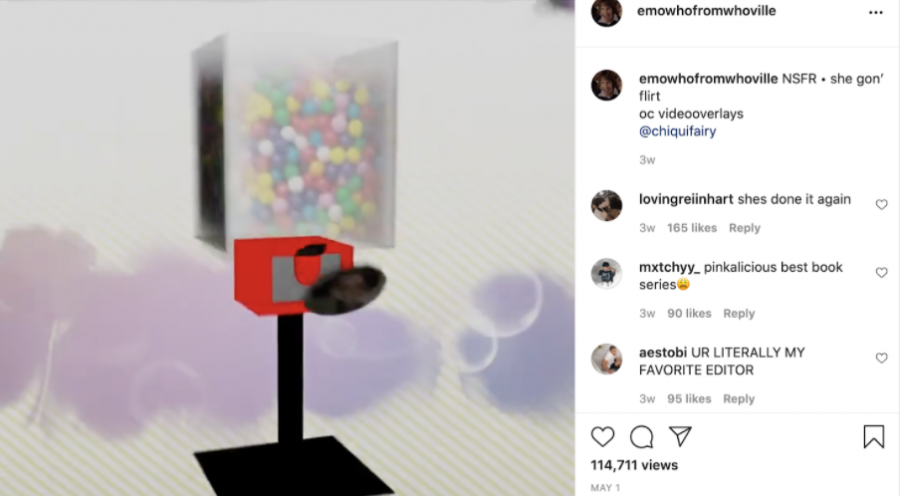The Art of Vidding
A dive into the unique, transformative fan practice.
@emowhofromwhoville, Instagram
“I went through a whole pack of gum last week, so while making my last edit, I decided to sculpt a 3D model of a gum ball machine. Because I like to just wait dormant for inspiration to strike, my edits take me anywhere from 8 hours to an entire week,” said Lauren, a teen video editor who runs the Instagram @emowhofromwhoville with an audience of 193k followers. (Click to watch)
Scroll long enough on social media and you will inevitably stumble upon a video edit. These are short clips of the world’s favorite movies, shows, or celebrities, edited together by teenagers into a strangely addicting final cut. With Generation Z’s obsession over video content and our unique social media skill set, these video edits (both the consumption and creation of them) have taken the internet by storm.
Video edits often center around a specific fandom. By ordering clips, overlaying voiceovers, and adding evocative music, video editors remix existing works into new narratives. “When I was in second grade, I made my first Instagram fan account for the show Dance Moms and posted video and photo edits of the cast,” said Lauren, an 18-year-old video editor and YouTuber who hails from the Bronx. Her YouTube videos and Instagram edits have collectively garnered over 21 million views. “I’ve gone through numerous fan accounts, each time using a more advanced editing program and building my skill.”
There are editing accounts on social media with millions of subscribers, likes, comments, and shares. Long form video edits take shape as fan trailers and even fan cuts of movies. Some teenagers have expressed their desire to be in a video edit of their own. With Gen Z having grown up with the internet, fandom has shaped our adolescent experience, and vidding has always been a part of that.
“When it comes to music, a show, or a movie, people love to spend time focusing or hyper fixating on what makes them happy,” said Lara Popovic ’22, who comes across video edits almost every day. “For some it’s a form of self expression, for others it’s a hobby, and for some it’s a way of coping with daily struggles,” she added.
Some companies have replicated the fanvid format for multimedia advertising campaigns. Because teenagers so often jump to social media after consuming content, video edits can become an incentive to dive deeper into a particular brand. It is addictive because, “video editors always compose the best movie scenes into one edit,” said Melanie Candelo, a junior at NEST+m who enjoys watching video edits on Instagram. “The transitions are always on beat with the music,” she added, suggesting that our natural affinity for beat drops and predictive timing might just play a role in the vidding craze.
Fanvidding started decades ago when Star Trek superfan Kandy Fong created the first official fan video in 1975 — a slideshow of Star Trek images set to the song, “What Do You Do With a Vulcan.” Following in Fong’s footsteps, vidders learned to use multiple VCRs to edit clips together. These fans, usually gathering at conventions, later taught themselves how to edit using early computer software. The process is easier than ever today with powerful editing tools in most kids’ pockets.
Though vidders are technically self-taught artists, vidding (like the concept of fandom itself ) has always been community-based. “Every single editor is evolving and experimenting in their own way, which is why we are all able to appreciate each other’s efforts and praise one another,” said Lauren, who posts After Effects tutorials on her YouTube account. There is competitiveness within the community, but, “I think one thing that has really unified our generation is our love for consumption.”

Fan studies has also solidified into an official academic discipline for the last 40 years. In 2013, The Museum of Moving Image curated the exhibit “Cut Up” about remixed videos. MIT’s New Media Literacies project featured a documentary series about the art of vidding in 2007, working in tandem with the Organization for Transformative Works (OTW).
What is the biggest challenge for vidders? Without a doubt, that would be Digital Millennium Copyright Act (DMCA) restrictions. As, “a nonprofit organization run by and for fans,” the OTW — most known for running AO3 — launched a legal advocacy project in 2007 to address the issues. The Electronic Frontier Foundation, in partnership with the OTW, successfully applied for a DMCA exemption to allow for the use of DVD clips in noncommercial fanvids in 2008. The legal team must re-apply for the exemption every three years.
In America, “there is no broad class of work that is automatically safe to make without fear of challenge. The OTW’s position is that transformative, noncommercial fanworks are fair use, but transformativeness is always a factual question and can vary from fanwork to fanwork,” said Betsy Rosenblatt, University of Tulsa Professor of Law and OTW Legal Committee Member, in an e-mail to me. However, “it’s usually not worth it economically for copyright holders to prosecute the average person.”

With the rise of more open access-video sharing platforms for transformative works, the community has only grown bigger, and “fandom activities are becoming commercialized,” said OTW staffer Claudia Rebaza. “Remixes are a wonderful example of user response to commercial entertainment and the ideas being put forth by that content into our culture,” she added.
A book about vidding, “Vidding: A History,” by Muhlenberg College Professor Francesca Coppa will be released in 2022. In the meantime, vidding continues to evolve as trends fluctuate, leaving undeniable effects on media culture and on the individuals that engage in the community. “It’s probably something of a milestone that this year’s Best Director [Chloé Zhao] and Best Screenplay [Emerald Fennell] Oscar winners weren’t just women, but women who have talked about their fanfiction and fandom experiences,” said Rebaza.
For teens, video editing can teach essential management, collaboration, and media skills. “Through video editing, I’ve become my own boss in a way because I am a self-employed Content Creator. The work I do on social media is my first job, and the money I’ve earned has allowed me to support myself,” said Lauren, who will be attending Brown University this fall. “Editing has allowed me to inspire others to pursue their interests which has gifted me the most important thing of all: self-fulfillment.”
“It’s probably something of a milestone that this year’s Best Director [Chloé Zhao] and Best Screenplay [Emerald Fennell] Oscar winners weren’t just women, but women who have talked about their fanfiction and fandom experiences,” said Claudia Rebaza, staffer at the Organization for Transformative Works.
Marian Caballo is a Copy Chief for ‘The Science Survey,’ and she is elated to be on staff for a second year. She is drawn to journalism because it...

